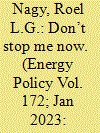|
|
|
Sort Order |
|
|
|
Items / Page
|
|
|
|
|
|
|
| Srl | Item |
| 1 |
ID:
125729


|
|
|
|
|
| Publication |
2013.
|
| Summary/Abstract |
In 2001, Australia introduced legislation requiring investment in new renewable electricity generating capacity. The legislation was significantly expanded in 2009 to give effect to a 20% Renewable Energy Target (RET). Importantly, the policy was introduced with bipartisan support and is consistent with global policy trends. In this article, we examine the history of the policy and establish that the 'stop/start' nature of renewable policy development has resulted in investors withholding new capital until greater certainty is provided. We utilise the methodology from Simshauser and Nelson (2012) to examine whether capital market efficiency losses would occur under certain policy scenarios. The results show that electricity costs would increase by between $51 million and $119 million if the large-scale RET is abandoned even after accounting for avoided renewable costs. Our conclusions are clear: we find that policymakers should be guided by a high level public policy principle in relation to large-scale renewable energy policy: constant review is not reform.
|
|
|
|
|
|
|
|
|
|
|
|
|
|
|
|
| 2 |
ID:
107630


|
|
|
|
|
| Publication |
2011.
|
| Summary/Abstract |
Within the EU, there have been calls for governments to provide greater certainty over carbon prices, even though it is evident that their price risk is not entirely due to policy uncertainty. We develop a stochastic simulation model of price formation in the EU ETS to analyse the coevolution of policy, market and technology risks under different initiatives. The current situation of a weak (20%) overall abatement target motivates various technology-support interventions, elevating policy uncertainty as the major source of carbon price risk. In contrast, taking a firm decision to move to a more stringent 30% cap would leave the EU-ETS price formation driven much more by market forces than by policy risks. This leads to considerations of how much risk mitigation by governments would be appropriate, and how much should be taken as business risk by the market participants.
|
|
|
|
|
|
|
|
|
|
|
|
|
|
|
|
| 3 |
ID:
188571


|
|
|
|
|
| Summary/Abstract |
Once a subsidy scheme is close to reaching its goal or loses political support, it may be terminated. An important question for policy makers is how to minimize the negative impact of the risk of subsidy termination on industrial investment. We assume the social planner aims to increase capacity and welfare and uses a subsidy, which has an uncertain lifetime, for the purpose. We examine a monopolist supplying an uncertain demand, faced with the option to expand capacity by irreversibly investing in small increments. We find that the firm installs capacity expansions sooner and, consequently, installs a larger capacity than a firm without a subsidy. A firm’s total investment during the subsidy’s lifetime increases with both the subsidy size and the likelihood of subsidy withdrawal. However, this happens at the cost of less investment directly after the subsidy has been retracted. The optimal subsidy size strongly depends on the point in time at which the social planner aims to maximize the welfare — the further into the future, the larger the welfare optimal subsidy. Furthermore, the welfare optimal subsidy size strongly depends on the social planner’s discretion over adjustments to the subsidy size.
|
|
|
|
|
|
|
|
|
|
|
|
|
|
|
|
| 4 |
ID:
118175


|
|
|
|
|
| Publication |
2012.
|
| Summary/Abstract |
Preferential trade agreements (PTAs) limit member-states' trade policy discretion; consequently, policy uncertainty is mitigated. Reductions in policy uncertainty stemming from accession to a PTA improve the resource allocation decisions of the voters and reduce deadweight losses from the need to self-insure against policy uncertainty. The resultant increase in efficiency improves an incumbent government's-particularly a democratic government's-chance of surviving in office. We test this prediction using survival analysis, adjusting for potential selection biases using propensity score matching. We find robust support for the proposition that governments that sign PTAs survive longer in office than observationally similar governments that do not sign. In addition, we find that this effect is stronger in democracies than in autocracies.
|
|
|
|
|
|
|
|
|
|
|
|
|
|
|
|
| 5 |
ID:
171431


|
|
|
|
|
| Summary/Abstract |
Although innovation and support schemes are among the main forces that drive investment in renewable energy (RE) technologies, both involve considerable uncertainty. We develop a real options framework to analyse the impact of technological, policy and electricity price uncertainty on the decision to invest sequentially in successively improved versions of a RE technology. Technological uncertainty is reflected in the random arrival of innovations, and policy uncertainty in the likely provision or retraction of a subsidy that takes the form of a fixed premium on top of the electricity price. We show that greater likelihood of subsidy retraction (provision) lowers (raises) the incentive to invest, and, by comparing a stepwise to a lumpy investment strategy, we show how an embedded option to adopt an improved technology version mitigates the impact of subsidy retraction on investment timing. Specifically, we show how stepwise investment facilitates earlier technology adoption compared to lumpy investment, and that, under stepwise investment, technological uncertainty accelerates technology adoption, thus further offsetting the incentive to delay investment in the light of subsidy retraction.
|
|
|
|
|
|
|
|
|
|
|
|
|
|
|
|
|
|
|
|
|